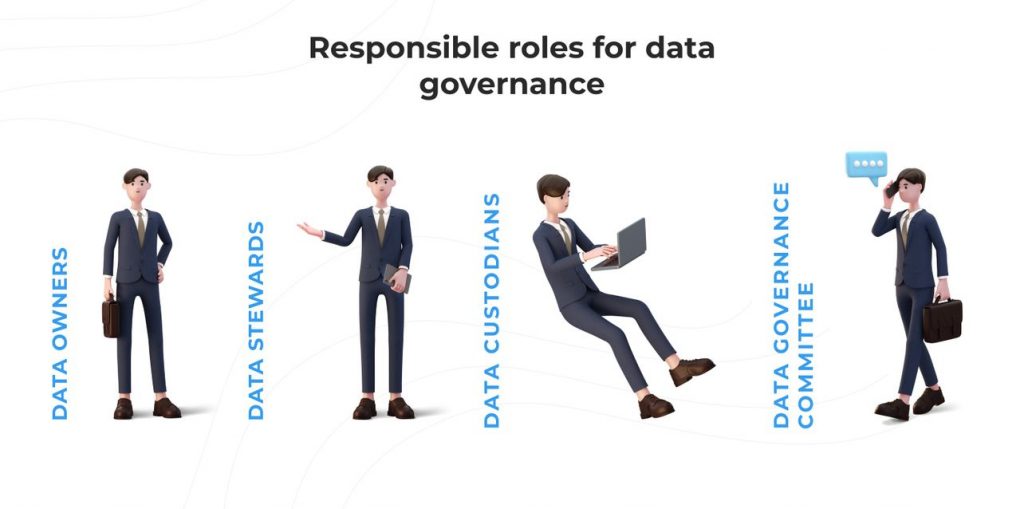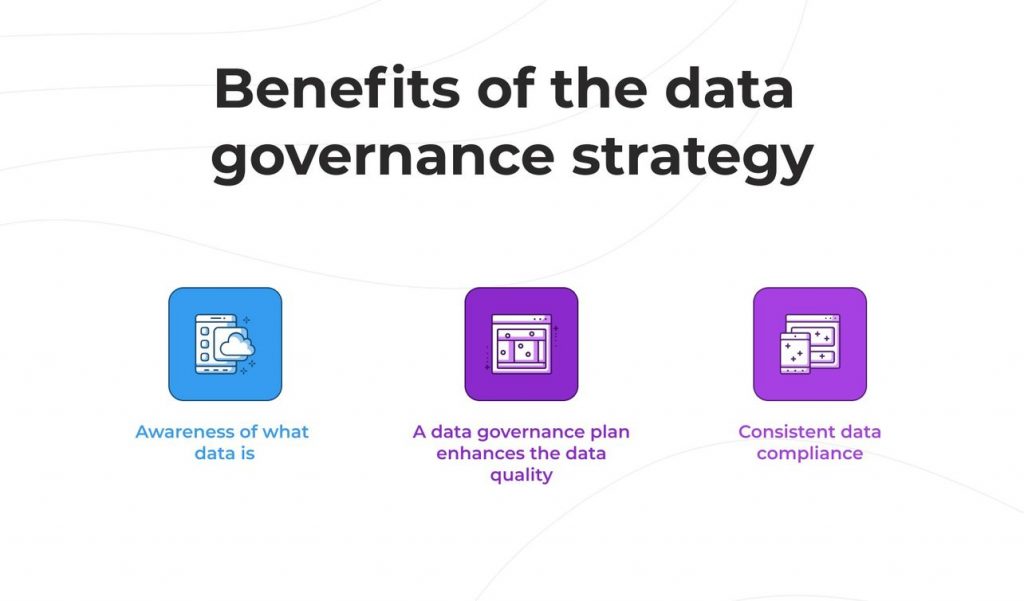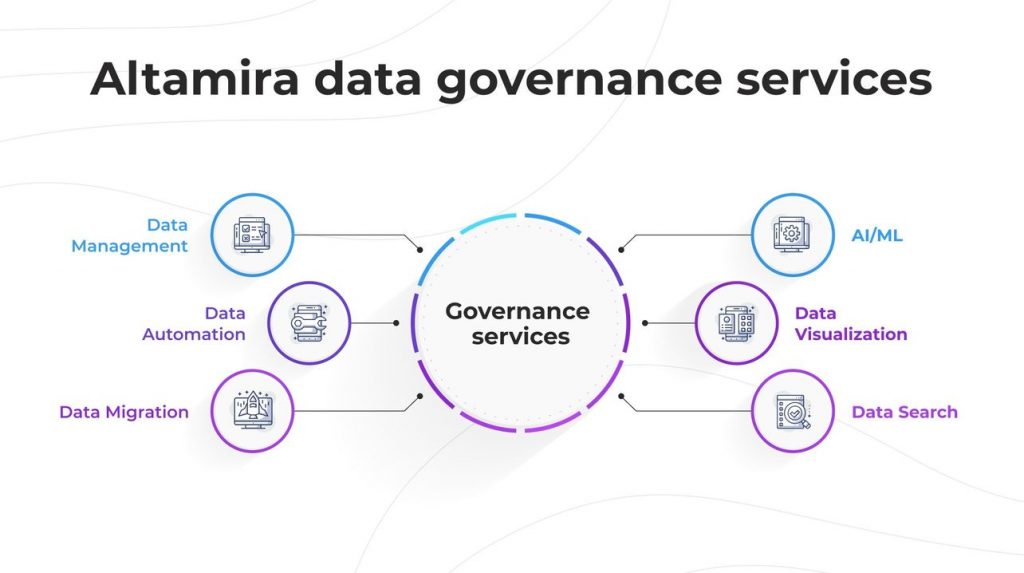Table of Contents
These days, businesses seize tons of new data coming from various sources. Some information brings the business asset, while some remain useless and just take the database’s place. Data governance aims to structure and manage data that comes from internal and external sources, define valuable and useful data, mitigate risks of its loss and convert raw data into meaningful data in order to apply the data-driven approach in the decision-making process.
Further, in this article, we would like to deepen in the term of data governance, what processes it consists of and what data assets its implementation brings for businesses.
What is data governance?
Data governance is the strategy that includes a certain set of tools and processes of standardization, storing, managing, and accessing business data collected from various sources. To know what sources should be considered in data governance strategy, you need to precisely understand what data for your business is, meaning what information is vital and what is not.
There are two basic things of effective data governance – the first one is to store the data structure, and the second is to keep the data safe using data protection rules laws like GDPR, HIPAA, and others according to the business niche specifics.
To execute the data governance strategy for your inner workflows, you need to assign responsible employees for collecting, standardizing, and storing business data making it simple to read for all company departments.
Responsible roles for data governance framework

Data Owners
Data owners are responsible managers for providing valuable data for crucial decisions-taking processes. They are aware of the data requirements and make business decisions based on this data that will influence the whole company.
Data Stewards
Data stewards can also be named data architects, included in a company’s technical team. They are tasked with constant monitoring of the ways data is collected, stored, and used within the company and its inner processes according to the data standards. Basically, data stewards work on standardization of all data coming to your company from various sources and follow data usage within the inner systems and apps. They also consult the team on what the data element means and how and what purpose it can be used for.
Data Custodians
Data custodians maintain the inner business information that is related to the company’s internal process, knowledge bases, databases, etc., and keep it stored according to the data policy and standards. They are responsible for constant access to this information by the entire team as well as certain employees.
Data Governance Committee
The data governance committee is the company authority that is accountable for the creation of company data policy and standards, meaning what data sources are acceptable, and how the data has to be stored, accessed, and used within the department and workflows. Depending on the size of your business, the general data governance committee can consist of several departments to provide data assistance to different groups like employees, clients, etc.
The data governance team members
The aforementioned roles of people responsible for data governance within your company create the entire data governance team, which is a must-have authority for businesses that want to receive valuable data assets and insights from the incoming information. Along with the member of the data governance committee, that we mentioned in the previous point, the data governance team should also include the following specialists:
- Manager – the top responsible employee for data governance execution within your company;
- Solution architect – accountable for designing and implementing data governance tools and apps required for maintaining policy;
- Data analyst – follows the data analytical trends to integrate them into your workflow;
- Compliance Specialist – monitor the maintenance of data policies and standards during the aforementioned data governance processes.
Moreover, it is crucial to document the roles and responsibilities of each role that takes part in effective data governance and its management.
Types of data governance tools
The creation and implementation of the data governance policy will be executed smoothly by using certain data governance tools and applications. Among the common software solutions that are commonly applied for introducing data governance policy and standards within businesses, we would like to mention the next.
Visualization apps
This type of tool is accountable for representing the inner data ecosystem including all internal and external sources where the data is collected, distributed between internal processes and workflows, and so on. It is used for the purpose of providing easy-to-understand data and reporting.
Data management
This software solution structures the data according to its specifics and standards, providing different levels of access and management. Thus, the data will be used much more effectively for data governance.
Data governance policy management
This solution is a must to ensure that data governance policies and standards are strictly followed within each branch, department, and staff. Only keeping the policy management and the data governance framework will be profitable for your business.
Data security management
The data governance process needs to entail high-security measures to prevent data breaches as the data your company maintains is related to your staff, customers, vendors, etc.
Benefits of data governance framework for your business
To sum up the aforementioned features and functions of data governance, we would like to emphasize what real benefits the implementation of the data governance strategy brings to your company.

Awareness of what data is
Talking about the value of business data, it is pivotal to understand what data actually is, and what information and its components provide value for your business development. So foremost, data governance framework defines the data your company is interested in.
A data governance plan enhances the data quality
Your employees may receive, send and exchange various data with each other, other departments, company branches, providers, etc. However, if the outgoing and incoming data is not structured and is not stored accurately, there will be no sense and profit from collecting it. Thus, a data governance strategy entails accurate storing and managing of data for all current sources.
Consistent data compliance
Data privacy is regulated by certain government laws and regulations where some of which are applied in all niches and some are peculiar just for individual industries, for instance, HIPAA for healthcare. A data governance efforts ensure your company strictly follows and maintains the industry data privacy regulations and requirements, especially it relates to the data of your customers.
Enhanced data management within your company
The integration of a data governance framework enables data-driven decisions by human resources within your company. Thanks to using software tools to apply data governance, the data is stable, easily accessed, and managed, which also simplifies the process of storing new data and acquiring updates in data privacy legal systems.
Challenges of Data Governance
Despite the numerous benefits that data governance is capable of introducing into your inner process, there is still a range of disadvantages and challenges that await you in this process that needs to be considered and discussed before the implementation of the data governance strategy.
The lacking of data governance leader
Once you decide to create and launch the data governance framework for your business, you have to hire experienced specialists particularly for applying and managing the data governance program execution. Such specialists are named Chief Data Officer or Chief Information Officer. If you neglect to hire the subject-matter expert and dedicated the integration of a data governance plan to incompetent employees, the strategy will fail before its start.
The data governance team is not formed
Nevertheless, hiring a CDO or CIO is not enough to cover all aspects and processes involved in the application of a data governance program for your company. The data governance team will correctly distribute the taste and responsibilities in order to maintain the data governance program. Some engineers will be responsible for keeping the data security regulations, others for checking the data resources, and so on. The data governance plan will not work beneficial for your case if vital duties are missed due to lacking staff.
There is no common understanding of the data assets
Each member of your team needs to understand the value of data and data governance strategy and needs to understand that only well collected, structured, and easily accessed business data can be used for effective utilization for these or those processes and business purposes. If the data assets are not clarified, then you may probably have issues with the data governance application.
Data governance is not equal to data management
Data governance includes data management, but the data governance program has a bigger purpose and asset than the data management process. Thus, data management is applied to accurately store and structure data for further analysis, reporting, and decision-making. If the data management process is poorly organized, then data security and compliance decrease.
Best practices in applying data offering
Taking into account the pros and cons of the creation and integration of the data governance strategy, further, we are going to share practices and methods of how to start and apply for a data governance program within your company.
#1 Specify the data formats
Choose the data formats acceptable within your inner system, using software solutions to keep those data formats standardized within the entire data ecosystem. As data flows from numerous external and internal sources, all this information needs to be stored according to acceptable data formats and standards.
#2 Consider unmanaged data sources
Data governance entails structuring all, literally all data used within your business processes – each knowledge base, file, document, and folder must be structured to bring the asset, instead of simply existing in your databases.
#3 Outline the business goals you want to reach
Be aware of the purposes of implementing a data governance program within your company. Set realistic goals and deadlines, consult on them with your CDO or CIO, and regularly synchronize the original plan with ongoing results.
#4 Make the process simple
It is not necessary to devote each step of your data governance plan to each member of your staff. Try to minimize the impact of the upcoming changes on your employees that are not related to data governance to prevent stress and misalignment with the team. The onboarding will be required when the program is completed and ready to launch.
#5 Assign responsible roles
As aforementioned, data governance strategies involve different specialists and their roles in launching the plan for your company. Make sure your data governance team includes all required engineers to turn the expected data governance plan into reality.
#6 Implement metrics to track the progress
The metrics help you assess the effectiveness of the data governance strategy and practices that were applied by your data governance team. It helps evaluate the amount of outdated data that keeps being stored, the amount of structured data managed by data owners, the progress in maintaining data standards and compliance, the level of data protection, etc.
Altamira data governance offer
We help our clients to build and acquire data governance strategies for their businesses. But we also know that explaining the asset of implementing data governance is fundamental in its process to make it efficient.
Therefore, we are paying much attention to analyzing the current data management process and the software tools that are integrated within your inner processes to build an accurate action plan for acquiring a new data governance program. Our data governance services include the following:

- Data management – this process helps to reveal the data asset that hasn’t been used for your business profit before, which entails defining the general data structure your company has currently and developing a strategy to get the value from collected data and implement a data-driven approach in decision-making;
- Data automation – the process of automation of the way data is collected, processed, and stored with the implementation of automation software applications that will create a single data flow for the inner software system;
- Data migration – converting the outdated data structure into modern infrastructure;
- Artificial intelligence & machine learning – automation of the manual processes with AI/ML technologies, particularly implementing image recognition function, natural language, voice recognition, and chatbots within your software ecosystem;
- Data visualization – visualization of how the data flows into your company from external and internal sources and defining how to convert the raw data into meaningful data for vital business decisions;
- Data search – due to the tons of information your company receives on a daily basis, enabling quick and accurate data search is a must feature of data governance strategy using search technology tools.
If you are willing to learn more about the benefits and significance of the building and integrating a data governance strategy for your case, then let our team help you reveal the hidden issues with your data and turn them into assets.



